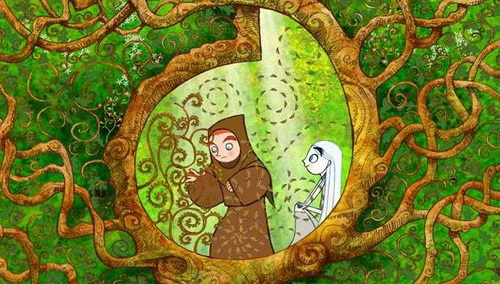Photograph of totem poles depicting family crests.
Appropriation is not entirely an issue of one culture abusing the work of another. Several cultures participate in self-appropriation: the use of one’s own historical artistic traditions in a way that abandons (or even violates) the art’s original intent and use. An excellent example of this, I believe, is Native American art. I am hesitant to use the broad term “Native American art” because each tribe has distinct cultural practices and, as a result, unique artistic motifs. However, to the lay non-Native person, there is a certain concept of what art produced by Native Americans looks like, and it is to this general style that I refer. Native Americans in popular culture have been recognized by a series of heavily-entrenched stereotypes for hundreds of years: totem poles, feather headdresses, tipis, tomahawks and the like. However, there are certain instances in which Native people indirectly reinforce these stereotypes by utilizing their cultural heritage in ways that it would never have been used before the intrusion of Western culture. Some Native American casinos are populated with images that would have traditionally been held with more respect by the tribes. Totem poles, for instance, were in most cases extremely important cultural artifacts for tribes on the northwest coast of America
Seven Cedars Casino logo
Seven Cedars Casino facade
With this history in mind, observe the Seven Cedars Casino and Resort, located in Sequim , Washington
Illustration from the Book of Kells
I think Ireland Ireland Ireland Dublin ’s Trinity College Ireland
Still from "The Secret of Kells"
Recently, the Book was used as an inspiration for an animated film called The Secret of Kells. The film is about a young boy living in Kells Abbey in the early ninth century who meets the master illuminator of the Book of Kells and learns that it is his duty to complete and protect the manuscript (Bynum). In addition to the story, the film also takes its visual cues from the Book, using character designs stylized like the manuscript’s original portraits and backgrounds reminiscent of its decorative motifs (fig. 18). The creator, Irish animator Tomm Moore, said in an interview “[Kells] is kind of the high point Moore







The whole thing about using past, culturally important (or not) heritage art in a bit of a, let's just say, irreverent way is interesting, but ultimately, I don't think one could say one kind of appropriation, e.g. Warhols, is better than another, e.g. American Indian - especially as American Indian history is totally whack. And what do you do as a demarcated, ostracized (to the extremes of being swept out of Normal Society onto reservations, &c.) 'other' to get the business (i.e. resources, money, livelihood!) from the Normals is going to be different than being a bit irreverent towards one's history, like the Book of Kells thing seems to me.
ReplyDeleteAnd in any case, I feel, one ought be able to create or make or appropriate as they see fit. Right?
Egh!
Warhol's.*
ReplyDeleteWell, as far as getting business from the "Normals", there are plenty of Native American casinos that don't use this imagery. In fact, I'm painting the situation rather unfairly. I just thought that the Seven Cedars was particularly interesting - it's kind of unreasonable of me to make sweeping claims about Culture, since in this case it's a select group of specific people doing the appropriation.
ReplyDelete....Actually, the more I look at it, the worse I feel about the Seven Cedars section in the context of the rest of the paper. It's not representative of Native American culture at large, but I imply that it is. Plus, I'm probably more critical of the casino than of any other appropriator in the paper, which is unfair.
ReplyDeleteAh well, the paper is already written. Consider this my disclaimer: the examples given in this section are not intended to broadly represent Native American or Irish culture as they concern appropriation; rather, they are more effective as stand-alone examples of a strange phenomenon practiced by individuals, not entire cultures.
Well, in any case, there are hundreds of distinct 'Native American cultures,' we just see them as ONE, which is already unfair, anyway.
ReplyDeleteAppropriation or copycatting or whatever -- we don't like those things, do we? I feel like, as a broad, generalized culture, we like Original Art.
We tend to be very critical of Non-Original Art. I guess my overall goal with this paper was to point out the more legitimate uses of appropriation that people may not have thought about. Not defend it, per se, but just show that it can be used respectfully and to good effect.
ReplyDelete